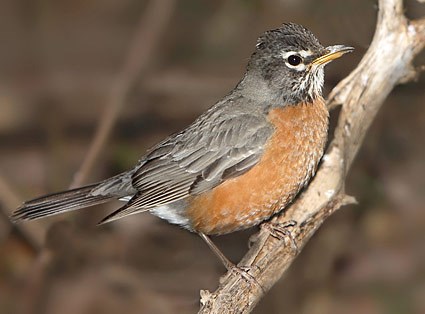
By Joe Phipps, Staff Writer
The weather becomes more and more like spring each day, and new spring milestones are being reached every week.
This week has marked one of the most fundamental milestones: the return of the robin. And no, “the return of the robin” isn’t the latest Batman sequel. It’s the return of one of America’s most familiar suburban bird.
Not many people can differentiate between a hawk and a falcon, but everyone knows what their friendly backyard robin looks like.
The robin (Turdus migratorius) is seen by many Americans as it sits on lawns catching earthworms. While the bird is found commonly in the Bloomington area, during the winter many birds travel south, and those that stay tend to gather in large flocks in wooded areas such as Ewing Park.
During normal winters, groups of robins will stay on campus near the unmarked “hot spots” next to McPherson, which are caused by the underground heating that runs across campus. But few days were cold enough to bring the robins back.
Not many people seem to notice the robins leave during the winter, and you rarely hear someone say, “Boy, I sure do miss those robins.” When you walk through campus in January the only natural noise breaking the silence is the harsh call of the crow, it’s hard not to wish for the beautiful song of the robin.
For those students who still haven’t experienced the robin’s music this year, they are most often found eating worms in front of Presser Hall and also eating the berries from the trees along Park Street next to Shaw Hall.
They are unmistakable with their dark heads and gray back contrasted by their bright orange breasts and bellies.
Soon the robins will settle into our area for the summer and begin to mate and make nests—they are among the first birds to breed in the spring. It is extremely likely that students who live off campus may find a robin’s nest around their homes.
The nests are often exposed and in close proximity to people, and you may even find the shells from their eggs, so distinct they are given their own color “robin’s egg blue.”
Contrary to popular belief, robins do not use their beaks to “listen” for earthworms, but instead they run and catch worms completely by sight. They eat not only worms and berries, but also many other invertebrates such as grubs, caterpillars and grasshoppers.
As depicted in many cartoons and movies, the young are fed primarily worms as they stare, mouth agape, towards their parent.
It’s likely someone may find a baby robin fallen from its nest. Should this happen, forget what your mother told you. Touching a baby bird doesn’t mean it will be rejected by its mother, so it is acceptable to put a baby back into the nest if it is lost.
This myth also goes for other animals, but it is especially untrue with birds, which don’t have a very good sense of smell.
After the unpredictable winter weather we just experienced, I’m glad to have the appearance of these robins as a sign of spring coming early.
